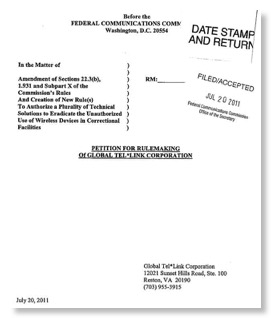Petition Filed to Stop Contraband Cellphone Use in Prisons
The topic of illicit cellphone use in prisons has been a recurring topic here even though there has been no explicit FCC action on the topic other than a workshop almost a year ago. Indeed, while FCC waited over 2 years to ask for any public comment on CTIA’s November 2, 2007 petition on cellphone jamming and customer-owned bidirectional amplifiers, it has so far ignored all the jamming issues in that petition - both prison-related and otherwise. (The Docket 10-4 public notice seeking comment on this and other petitions avoids all mention of jamming issues of any type and focuses solely on the amplifier section of the petition.) But FCC is being somewhat even handed here: They have ignored both CTIA’s attempt to have all jammers declared illegal and the July/August 2009 petition of the South Carolina Department of Corrections and 30 other states to allow jamming in prisons to control illicit cellphone use. Except for the above mentioned workshop, FCC has taken no visible action to control cell phone use in prisons. (Of course, being caught between the powerful CTIA and state governments is not a desirable place to be.)

Carl Lackl, Jr. (l) a Baltimore witness murdered as a result of a prison cell phone call.
Capt. Robert Johnson (r) South Carolina Department of Corrections, shot 6 times
at his home as a result of a prison cell phone call.
The GTL petition addresses both jamming and “managed access” - interception and blocking of calls based on their location and possibly with a “green list” of cellphones that may make calls at or near prison property. The petition states,
“Managed access systems are generally favorably viewed, yet they are too costly for most deployments and complicated to authorize given the need to negotiate spectrum sublease agreements with multiple wireless telecommunications carriers. This petition presents a proposal to amend the Commission’s rules to streamline the spectrum lease process so that spectrum lease agreements, when needed, are obtained in a shorter period of time.”
It also seeks to clarify the obligations of a managed access system with respect to E-911 services and involve the local PSAP operator in determining what is appropriate for a given area.
Finally it asks the Commission to finally act on determining whether CTIA’s interpretation of Section 333 (that the Commission does not have the authority to permit jamming by non-federal entities) is consistent with the statute. It argues that FCC should consider the legislative history of Section 333 as well as the plain reading of the Communications Act that whatever Section 333 means it must apply equally to both FCC and NTIA since it does not differentiate between the two agencies. (Section 305 exempts the President and NTIA from Sections 301 and 303, but not from the rest of the Communications Act. Also, Section 333’s contemporary on satellite jamming, 18 USC 1367, specifically excludes “any lawfully authorized investigative, protective, or intelligence activity of a law enforcement agency or of an intelligence agency of the United States” while Section 333 is silent on this point.)
Let’s hope that FCC finds this petition in its inbox and takes some action on this important issue that has been ignored for so long. Sources in FCC report that there is no centralized tracking of petitions that are received but have not been put out for public notice. So even the 8th Floor may not be aware of this petition and its issues.
UPDATE
On 9/6 CellAntenna Corporation filed a related petition with FCC. So FCC now has 3 petitions dealing with various aspects of contraband cellphone use in prisons, ALL without any action.
The CellAntenna petition would “require CMRS carriers to do their part and suspend service to any wireless device reported to be operating in a correctional facility within one hour after receipt of notice from a Warden”. Of course, this approach could allow any smuggled cellphone to be used at least once and would be a boon to contraband smugglers.
So isn’t it time for FCC to at least put some of these petitions on public notice for comment?




![Validate my RSS feed [Valid RSS]](valid-rss-rogers.png)

